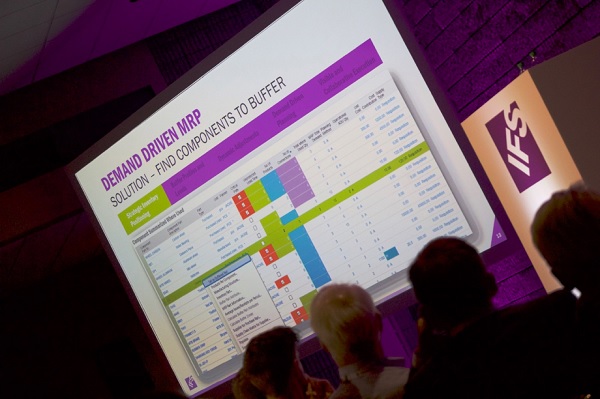Live blog coverage from the IFS World Conference 2018 breakout session, “Demand-driven material requirement planning: How to gain competitiveness in the ‘new normal’.”
In a literally standing room only session, Björn Archenholtz and Mats Johansson explained the principles of demand-driven material requirement planning (MRP) to a large, attentive and engaged audience.
In 2015, IFS started to seriously study demand-driven MRP and that ended up driving one of the biggest investments in IFS Applications 10.
MRP itself is not new, but product life-cycles have got shorter, products have got more individualized and customer demands are growing, with dropping lead times. Demand-driven MRP is a response to this, leading to 40 percent reduction in inventory, 80 percent reduction in lead times and more.
IFS Applications 10 is now compliant with the Demand Driven Institute. Here’s what that means…
A short history of MRP
In the 1960s, when MRP exploded, customer tolerance was long, but it shortened by the 70s, so they needed to adapt the planning systems to adapt with master scheduling. Forecasts are always wrong to some extent. But they get more wrong the furthest they go out. So, we added mitigation to those problems. Then there’s the bullwhip effect, where a small change in demand gets amplified up the supply chain. Messages from MRP systems are constantly changing. There is a natural variability that can’t really ever be dealt with. MRP plans are only achievable and realistic if everything in the dependent network goes exactly to plan. In some ways, it’s quite a fragile system.
Demand-driven MRP builds the buffers
Demand-driven MRP is about decoupling and buffers. It’s the usage of the decoupling points buffers that makes this unique; they are the quantity of inventory that will provide a reliable availability to the customers. At the same time, they allow aggregation of demand orders, creating a more stable supply signal to the supply chain. It’s like wave breakers in a marina.

Unprotected lead time is a new form of lead time at the heart of demand-driven MRP. The lead time is the longest cumulative time of the production chain. It’s highly theoretical because it assumes no availability of parts. If you buffer some parts, in a way that makes them always available, the unprotected lead time is just the time from the buffered components to the finished product. The further you bring the buffers up the process, the shorter the unprotected lead time is. And if that’s a competitive advantage, you’re in a good place: you can out-plan your competitors.
Strategic stock buffers are the keystone of this solution. They must never, ever be netted to zero. The buffers decouple MRP from demand-supply states and generate resupply orders as a function of buffer states.
Demand-driven MRP steps
- Strategic inventory position – which parts shall we buffer?
- Buffer profile and levels
- Dynamic adjustments to those
- Demand-driven planning
- Visible and collaborative execution – the management of open supply orders
The buffer system in the MRP is color coded. Green is OK, yellow means replenish and red means you have a problem on the way. Average day usage plays a big role in planning these buffer levels.
The system supports forecasting of the buffer size needs, too. We’re aiming for roughly right rather than precisely wrong. A Net Flow Equation is performed on every single part, base don on hand and open supply, less qualified order demand. If the Net Flow Position drops below the green zone, then orders are generated to top up to the top of the green zone.

The screen in the IFS Material Requirement Planning (MRP) allows you to see quickly, though color coding, which parts you need to act on and how quickly. Execution is the management of open supply orders against buffer status. There’s also a useful health check screen, that gives you an overview of the parts situation. If you’re in blue, you’re overstocked, but your focus should always be on the blacks and the reds in the system.
If you start working with this, it’s hard in the beginning, but once the buffers are set, you’ll have more time for coffee breaks.
Learn more about MRP at ifs.com.
Do you have questions or comments?
We’d love to hear them so please leave us a message below.